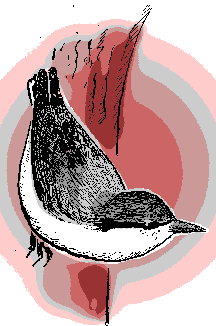PINE FOREST
Chihuahua State
| October 9
latitude 27º43'N, longitude 107º38'W MEXICO: Chihuahua; Arareko Ecotouristic Complex
±6 kms south of Creel; elev. ±2,330 m (±7600 feet); low hills mantled almost
exclusively with Arizona Pine, Pinus arizonica, little underbrush, much basaltic
outcrop
RESIDENCY STATUS:
permanent resident
winter resident |
- Black Vulture
- Turkey Vulture
- Cooper's Hawk
- Northern (Red-shafted) Flicker
- Williamson's Sapsucker
- Steller's Jay
- Common Raven
- Brown Creeper
- Pygmy Nuthatch
- White-breasted Nuthatch
- Mexican Chickadee
- Ruby-crowned Kinglet
- Yellow-rumped (Audubon's) Warbler
- Yellow-eyed (Mexican) Junco
|
For North American birders, the most
"exotic" species in the list may be the Yellow-eyed
Junco and Mexican
Chickadee. In the U.S., both of these species are restricted to the mountains
of extreme southeast Arizona and southwest New Mexico, but in Mexico they follow the
western highlands all the way into the deep south.
Yellow-eyed Juncos, called Mexican Juncos in older books, look just
like one of the phases of the Dark-eyed Junco common farther north -- except
for the eyes. Those eyes are the bright orange-yellow of U.S. school buses. They are so
conspicuous that they look unnatural.
Mexican Chickadees look almost identical to Black-capped and
Carolina Chickadees common farther north, but their voices are a bit lower and more buzzy
than those species'.
 The list's Pygmy Nuthatch
may not seem so unusual to Westerners because they are found at higher elevations all
through the US West. However, they're "exotic" to Easterners. In the US
Southeast we have the very similar Brown-headed Nuthatch, but that bird has a brown cap
while Pygmies have gray ones, and the Brown-headeds are strictly low-elevation folks.
Despite these differences, sometimes the two species have been lumped.
The list's Pygmy Nuthatch
may not seem so unusual to Westerners because they are found at higher elevations all
through the US West. However, they're "exotic" to Easterners. In the US
Southeast we have the very similar Brown-headed Nuthatch, but that bird has a brown cap
while Pygmies have gray ones, and the Brown-headeds are strictly low-elevation folks.
Despite these differences, sometimes the two species have been lumped.
The field guide says that Pygmy Nuthatches forage in small flocks
high in the pines. The one I saw, drawn at the right, was lower down on a trunk, and
alone. Maybe it had descended just for a quick look at me, for I had only that brief
sighting before it disappeared.
The list doesn't convey an important feature of Lake Arareko's
birdlife. Large parts of the forest here, at least during the middles of days, are
absolutely birdless. Except for wide-ranging hawks, vultures, jays, and ravens, all the
other species were seen almost exclusively in the little valley below the tent.
 The list's Pygmy Nuthatch
may not seem so unusual to Westerners because they are found at higher elevations all
through the US West. However, they're "exotic" to Easterners. In the US
Southeast we have the very similar Brown-headed Nuthatch, but that bird has a brown cap
while Pygmies have gray ones, and the Brown-headeds are strictly low-elevation folks.
Despite these differences, sometimes the two species have been lumped.
The list's Pygmy Nuthatch
may not seem so unusual to Westerners because they are found at higher elevations all
through the US West. However, they're "exotic" to Easterners. In the US
Southeast we have the very similar Brown-headed Nuthatch, but that bird has a brown cap
while Pygmies have gray ones, and the Brown-headeds are strictly low-elevation folks.
Despite these differences, sometimes the two species have been lumped.